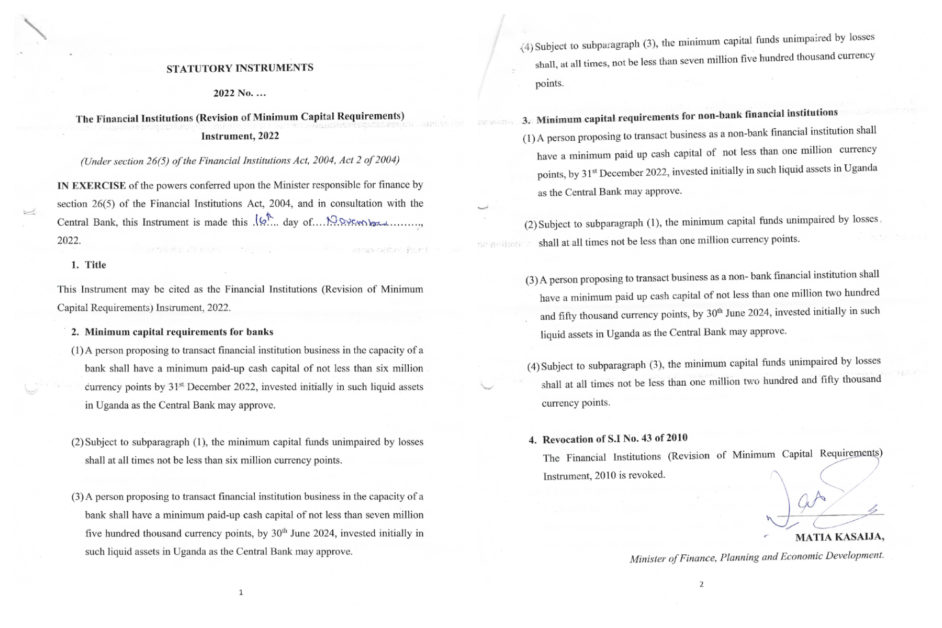Uganda’s Minister of Finance, Planning and Economic Development, Hon. Matia Kasaija, on 16th November 2022 signed a ministerial instrument, increasing the minimum capital requirements for banks by 6 times or 500%.
Capital requirements for non-bank institutions have also been increased by 25 times or 1900%.
Uganda had not changed its minimum capital requirements since 2010
According to the Financial Institutions (Revision of Minimum Capital Requirements) Instrument, 2022, a copy of which this writer has seen, minimum capital requirements for commercial banks have been increased from UGX25 billion (USD6.7 million) to UGX 150 billion (approx USD40.2 million) by 30th June 2024.
The increase shall be tiered, with all banks required to have upped their capital buffers to at least UGX120 billion (USD32.2 million) by the 31st of December 2022 and then UGX150 billion by the 30th of June 2024.
“A person proposing to transact financial institution business in the capacity of a bank shall have a minimum paid-up cash capital of not less than six million currency points by 31st December 2022, invested initially in such liquid assets in Uganda as the Central Bank may approve,” reads the instrument.
A currency point is equivalent to UGX20,000.
“A person proposing to transact financial institution business in the capacity of a bank shall have a minimum paid-up cash capital of not less than seven million five hundred thousand currency points, by 30th June 2024, invested initially in such liquid assets in Uganda as the Central Bank may approve,” the instrument further reads.

Financial Institutions (Revision of Minimum Capital Requirements) Instrument, 2022 repeals the Financial Institutions (Revision of Minimum Capital Requirements Instrument), 2010.
Under the same instrument, capital buffers for non-bank financial institutions, have been increased from UGX1 billion (USD268,000) to UGX25 billion (USD6.7 million) by the 30th of June 2024.
Similarly, non-bank institutions have been allowed to increase their capital in a tiered manner. As of the close of 31st December 2022, non-bank institutions were required to have at least UGX20 billion (USD5.4 million) in capital buffers.
The Central Bank was not immediately available for comment on the matter, but we do understand from our sources that the Central Bank has already communicated the revised regulatory regime to all the banks.
It is also not yet clear, how many of the 25 banks, 3 credit institutions and 5 micro-finance deposit-taking institutions, met the 31st December 2022 deadline and what will be done to those yet to meet the tight deadline.
The Central Bank kickstarted the consultative process of increasing capital buffers for Commercial Banks, Credit Institutions and Micro-Deposit Taking Institutions, in August 2021.
The Central Bank at the time said, “the increase in paid-up capital is long overdue and is intended to match the dynamism of the economy, incentivise shareholder commitment, enable institutions to withstand shocks and to converge with regional peers among whom Uganda effectively has the lowest paid-up capital.”
Capital buffers were last revised in 2010 under Financial Institutions (Revision of Minimum Capital Requirements Instrument), 2010.
